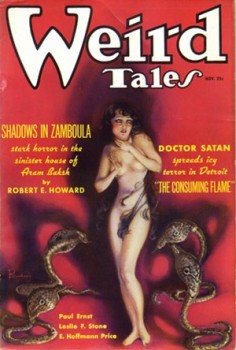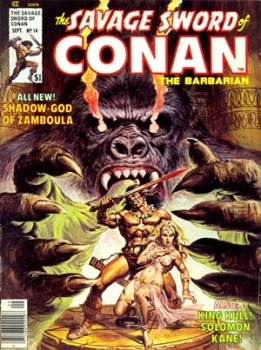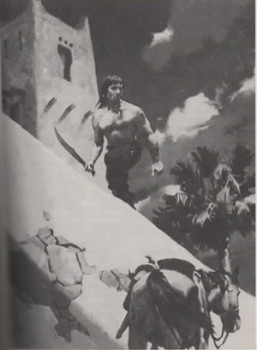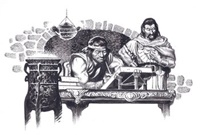Hither Came Conan: Steven H. Silver on “Man-Eaters of Zamboula”

Why “Man-Eaters of Zamboula” Is the Best Conan Story of All Time, with the Possible Exception of “Shadows of Zamboula,” which Is the Same Story, So It Really Is the Best of All Time
“Man-Eaters of Zamboula” is, without a doubt, the best, and most quintessential story about Conan the Barbarian written by Robert E. Howard. And since stories by other authors don’t count (with one exception noted below), that means that “Man-Eaters of Zamboula” is the absolute best Conan the Barbarian story ever written. I suppose a case could be made that “Shadows of Zamboula” is a better Conan the Barbarian story, but since the only difference between those two stories is the replacement of the phrase “Man-Eaters” with “Shadows,” I’d be willing to concede the point.
Howard first published “Man-Eaters of Zamboula” in the November 1935 issue of Weird Tales, where Margaret Brundage provided a lurid piece of cover art showing Zibibi naked and standing between four cobras preparing to strike, an image taken directly from the story’s climax.
The story has everything: a mysterious stranger giving Conan an enigmatic warning, which the Cimmerian completely ignores, a power struggle between a mad priest and a distant satrap and his power-behind the throne wife, mystical potions, star-crossed lovers, beautiful (naked) women, the one man who can give Conan a physical challenge, snakes, cannibals, revenge, a precious gemstone. You can practically see the over-the-top movie trailer proclaiming the various elements of Conan’s day in Zamboula, because all of that action takes place in a single day and night.
In the beginning, the story opens with Conan, bereft of all his possessions save the clothes he is wearing and his massive sword, walking through the Zamboulan suq. A Zuagir tribesman sidles up to Conan and warns him not to go to stay in the House of Aram Baksh because anyone who stays at the inn who isn’t a native Zamboulan winds up disappearing. Although Aram Baksh claims they’ve all left town, many of their possessions wind up being sold in the suq. The tribesman does not give a reason why a Zamboulan would spend the night at Aram Baksh’s, but the important part of the message is that Conan, under no circumstances whatsoever, should spend the night at the House of Aram Baksh.
Naturally, Conan immediately heads to the House of Aram Baksh to spend the night because it is inexpensive, located at the edge of the city, surrounded by a wall, and he has been told that staying there is a phenomenally bad idea. He also has already paid Aram Baksh for his night’s lodging even before getting the warning.
To be fair to Conan, he has also noticed oddities about Zamboula which would indicate that the city outside the walls of the House of Aram Baksh may not be the safest place to be, either. Few people are abroad after dark, even beggars. Houses are all surrounded by walls, or the ones that aren’t are vacant, with not even the said beggars deigning to squat in them. This is a mystery the Cimmerian notes, but files away for future reference.
 Just as Aram Baksh’s house is secured from the rest of Zamboula by a tall wall, so, too, is Conan’s room secure from the rest of the House of Aram Baksh. As the first chapter of the story ends, Conan is safely ensconced in his room, which has been demonstrated to be locked from the inside. If anything happens to him, it will be Howard’s presentation of a locked-room mystery.
Just as Aram Baksh’s house is secured from the rest of Zamboula by a tall wall, so, too, is Conan’s room secure from the rest of the House of Aram Baksh. As the first chapter of the story ends, Conan is safely ensconced in his room, which has been demonstrated to be locked from the inside. If anything happens to him, it will be Howard’s presentation of a locked-room mystery.
The second chapter presents Conan with the answer to the strange emptiness of Zamboula after dark, as well as offers him a beautiful, naked, dancer to save. The chapter opens up with Conan being attacked in his secure room, followed not only by his discovery of the way Aram Baksh has turned the room into a place to capture and kill his guests, along with learning that at night, cannibals roam the streets of Zamboula taking victims, and the cannibals have a deal with Aram Baksh a well. The locals naturally turn a blind eye to the cannibals because they only target foreigners, who nobody cares about, anyway.
While fleeing the house of Aram Baksh, Conan stumbles upon Zabibi, a beautiful naked dancer, who is fleeing her lover, a young Turanian soldier named Alafdhal, who had been drugged by Totrasmek, priest of Hanuman. Angry at Zabibi for denying his advances, Totrasmek drugged Alafdhal so he would be violent towards the dancer. Being the chivalrous barbarian he is, Conan agreed to raid the temple of Hanuman and force Totrasmek to lift the effects of the potion from Alafdhal.
And so, after acquiring a beautiful companion and fending off cannibals, Conan has the opportunity to raid a fane to a profane god. The temple is beautifully designed and contains the requisite number of statues, hidden passageways and chambers, mad priests (well, one, Totrasmek), and an enormous man whose sole purpose in life is to break people’s necks so they can be used in sacrifice without losing any of their vital blood for the god’s sustenance. While Conan often has physical challenges, this murderer, Baal-pteor, is the one who is closest to being able to best Conan based on physical strength. Baal-pteor puts up quite a struggle, trying to strangle Conan, but Conan, who strangled bulls as a child, prevails, well, also because he’s the hero of the story.
In the final chapter, Howard turns his attention to Zabibi. Conan has handled everything Howard, Totrasmek, Aran Baksh, and the fine young cannibals have thrown at him, but it remains to be seen how Zabibi does against the priest. He surrounds the still-naked woman with four cobras (remember the cover mentioned above) and she must dance around their venomous strikes to avoid a painful death. Not an ordinary dancer, Zabibi is able to twist and turn and avoid every strike until Conan can come to her rescue and see that the snakes are merely illusions caused by either Totrasemek’s magic or a hallucinatory that the priest has used against Zabibi. Conan kills the priest, grabs the antidote, and rescues Zabibi and Alafdhal, giving Zabibi’s lover the antidote to his madness.

Once back with her lover, Zabibi informs Conan that she won’t be able to fulfill the payment part of their bargain, always implied to be sexual intercourse with the barbarian, because although he is chivalrous, he also has needs. The problem, Zabibi explains, is that although Howard has included an enigmatic warning, a power struggle between a mad priest and a distant satrap and his power-behind the throne wife queen, mystical potions, star-crossed lovers, beautiful (naked) women, the one man who can give Conan a physical challenge, snakes, and cannibals, he still has more twists up his auctorial sleeve. Zabibi and Alafdahl are, of course, Jungir Khan, satrap of Zamboula, and his wife, Nafertari, who is widely regarded as the power behind Jungir Khan. They were in Zamboula in disguise as part of their power struggle with Totrasmek, which Conan has helped them win. Obviously, a person of her rank couldn’t have an affair with a Cimmerian barbarian. And so, Conan goes off to buy a horse and put Zamboula behind him.
But he is not without payment and not quite finished with Zamboula. Before he leaves Zabibi/Nafertari, she tells him that the Star of Khorala has been taken by Totrasmek and must still be in the temple of Hanuman and implores him to regain it for her. After he takes his vengeance on Aram Baksh and ensures that no other foreigners will fall victim to the innkeeper, Conan leaves Zamboula, musing on the fact that he recognized Nafertari the moment he laid eyes on her and that he pocketed the Star of Khorala when he first met Jungir Khan/Alafdahl. Howard not only allowed Conan to triumph over all of his enemies, but also dupe his erstwhile allies during his day in Zamboula, leaving the city to have other, lesser adventures.
“Man-Eaters of Zamboula” stands out as the best, most quintessential Conan story because Howard carefully and lovingly crammed every possibly cliché and trope into the story that he possibly could. Perhaps he might have tried to fit in a sorcerer, but Totrasmek manages to pull off acts of magic in addition to his role as a priest, so he fills that role. While Baal-teor may not technically be a monster, he does serve in that role to challenge Conan and Conan must also contend with marauding cannibals in the streets of Zamboula. Even more amazingly, the story has no negatives (while, it might, but the goal of this essay is to argue that it is the best Conan story, so if you want to see if there are negatives, you’ll have to go out and read it for yourself).
Because “Man-Eaters of Zamboula” is the best Conan the Barbarian story, it is no surprise that another author has felt the need to write about this desert city. In 1979, Andrew J. Offutt revisited Zamboula in a prequel novel, Conan: The Sword of Skelos, giving the Howard fan more background into the city and its politics several years before the story Howard wrote. Because Offutt chose to explore Zamboula, this novel makes him the exception noted in the first paragraph.
From the Dusty Scrolls (Editor comments)
This was the second-to-last Conan story written (“Red Nails” followed).
l. Sprague de Camp and Byron Nyborg wrote the “Star of Khorala,” which continued the story about the gem. It first appeared in 1978’s Conan the Swordsman. Conan seeks to return the Star to Marala, Queen of Ophir (for a reward, of course). She had been deposed, so Conan sets out to free her, but there are difficulties. She would reappear in The Hour of the Dragon, as the Countess Albiona.
Leonard Carpenter dropped his entertaining Conan the Raider in between Howard’s original and the pastiche just mentioned. Conan is tracking the thief who stole the Star from him. The three tales together make something of a ‘Star of Khorala Saga.’
Zabibi/Nafertari is absolutely not one of the helpless eye candy women Howard frequently dropped into his Conan tales. She is one of the stronger females leads this side of Valeria.
Dark Horse did not adapt this story. However, Roy Thomas (yes, THAT Roy Thomas), brought the Star into his The Road of Kings story line.
Marvel’s Savage Sword of Conan covered this story in issue 14.
Prior Posts in the Series:
Here Comes Conan!
The Best Conan Story Written by REH Was…?
Bobby Derie on “The Phoenix in the Sword”
Fletcher Vredenburgh on “The Frost Giant’s Daughter”
Ruminations on “The Phoenix on the Sword”
Jason M Waltz on “The Tower of the Elephant”
John C. Hocking on “The Scarlet Citadel”
Morgan Holmes on “Iron Shadows in the Moon”
David C. Smith on “The Pool of the Black One”
Dave Hardy on “The Vale of Lost Women”
Bob Byrne on Dark Horse’s “Iron Shadows in the Moon”
Jason Durall on “Xuthal of the Dusk”
Scott Oden on “The Devil in Iron”
James McGlothlin on “The Servants of Bit-Yakin”
Fred Adams on “The Black Stranger”
Next up: Keith J. Taylor on “Red Nails.”
 Steven H Silver is a sixteen-time Hugo Award nominee and was the publisher of the Hugo-nominated fanzine Argentus as well as the editor and publisher of ISFiC Press for 8 years. He has also edited books for DAW and NESFA Press. He began publishing short fiction in 2008 and his most recently published story is “Webinar: Web Sites” in The Tangled Web. Steven has chaired the first Midwest Construction, Windycon three times, and the SFWA Nebula Conference 6 times, as well as serving as the Event Coordinator for SFWA. He was programming chair for Chicon 2000 and Vice Chair of Chicon 7.
Steven H Silver is a sixteen-time Hugo Award nominee and was the publisher of the Hugo-nominated fanzine Argentus as well as the editor and publisher of ISFiC Press for 8 years. He has also edited books for DAW and NESFA Press. He began publishing short fiction in 2008 and his most recently published story is “Webinar: Web Sites” in The Tangled Web. Steven has chaired the first Midwest Construction, Windycon three times, and the SFWA Nebula Conference 6 times, as well as serving as the Event Coordinator for SFWA. He was programming chair for Chicon 2000 and Vice Chair of Chicon 7.
 Bob Byrne’s ‘A (Black) Gat in the Hand’ was a regular Monday morning hardboiled pulp column from May through December, 2018.
Bob Byrne’s ‘A (Black) Gat in the Hand’ was a regular Monday morning hardboiled pulp column from May through December, 2018.
His ‘The Public Life of Sherlock Holmes’ column ran every Monday morning at Black Gate from March, 2014 through March, 2017 (still making an occasional return appearance!).
He also organized Black Gate’s award-nominated ‘Discovering Robert E. Howard’ series.
He is a member of the Praed Street Irregulars, founded www.SolarPons.com (the only website dedicated to the ‘Sherlock Holmes of Praed Street’) and blogs about Holmes and other mystery matters at Almost Holmes.
He has contributed stories to The MX Book of New Sherlock Holmes Stories – Parts III, IV, V and VI.
And he is in a new anthology of new Solar Pons stories, out now.

I’m always entertained by Silver’s writings. (Non-fiction, anyway; haven’t really sampled his fiction.) He makes a cogent and persuasive case. I suspect he took a public speaking class at some point; if so, he did better in it than I did in mine.
To counter his argument, one would have to go outside it, since he doesn’t provide much of a purchase in what he gives us here. If I agreed with his assessment, I wouldn’t bother. But I don’t. So I’ll bother.
There’s nothing intrinsically wrong with this story. It’s just that, to me, it has the feel of a mid-range Conan, the kind of potboiler Howard often cranked out to get a sure sale and Brundage cover. Yes, it hits all the right elements, but at this stage in his Conan writing, Howard was usually aiming higher, trying to make statements about barbarism and civilization that summed up his own thinking on the subjects. Stories like “Beyond the Black River” and “Red Nails.” Matched against these, “Zamboula” has a paint-by-numbers feel.
But what do I know? That’s just my opinion, and I’m arguing against Steve Silver. Plainly, I’m doomed…
Brian – The last time I argued against Steve, he hung my stuffed Ren and Stimpy plushes from the ceiling above my desk in the Black Gate cellar….err, basement….I mean, writers’ suite.
Oh. And he set my car on fire. Yeah. That too…
Bob, I plainly must seek out a more powerful mage. Anyone remember who Willy Newbury resorted to when faced with a like problem? (Oh, wait. He was fictional…)
I spend lots of time with imaginary people…
I picked up a couple of nifty REH/Conan items at Windy City Pulp. I’ll see if I can put together a post on it.
Bob,
I think it should be required that all these REH posts should end with the statement, “In all honesty I’m just glad I didn’t have to defend “The Vale of Lost Women”.” 😉
James – That was the ONLY story that contributors asked me, “Who got….?”
Which pretty much sums it up!
I could have picked up (in plastic) the Weird Tales with “The Phoenix on the Sword” this weekend.
But I was afraid to. Seriously.
I don’t know if this is the best Conan tale, but what a story!
Beautiful, strong-willed woman – check
Death-Haunted night in an exotic locale – check
Treacherous, greedy villain who gets his come-uppance – check
Evil, leacherous priest who gets his come-uppance – check
Brutal & Sadistic killer who gets his come-uppance while daring to match his alleged strength against a REAL man – check
Conan outwitting them all because they just can’t believe that some beefy hick from the northern hills actually has a brain – check
Was I entertained? – check
Was I glad I didn’t have to defend “The Vale of Lost Women” – double check
Thank you Mr. Silver, but I do have one quibble: Conan does not strangle anyone in this story, neither Baal-Pteor nor any of the Cimmerian bulls of his youth. He just breaks their necks outright with a surge of Herculean strength.
Strangling your foes is for the Weak.
Brian, the easiest way to read some of my fiction is to look on this very site at https://www.blackgate.com/black-gate-online-fiction-the-cremators-tale/
She was his mistress, not his wife. And Conan says he broke a bull’s neck “before he was a full grown man”; not the same as “as a child”.
But a good Defense of the short story.
Steven has made a compelling argument without necessarily paraphrasing the story. While not one of my favourites it has made me reconsider a bit. Maybe I should give it a re-read. Oddly enough one of my abiding memories of this story is an image of one of the cannibals from SSOC, tribute I am sure to the artist of that issue. (Buscena, Alcala, Chan?)
Side note. Thanks Bob I never really read the stories and pastiches in intended sequence, so the whole Star of Marala sequence.
It’s one of only three or so Conan stories that so impressed me as a 17-year-old that I made a D&D pastiche of it for my players. I think I elaborated a bit on the House of Aram Baksh and replaced the strangulator guy with spiders that would put web around your neck and then run up a column and try and hang you.